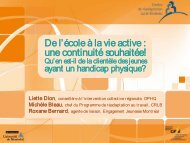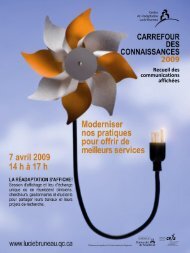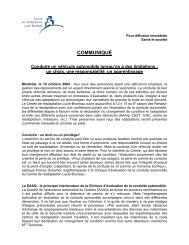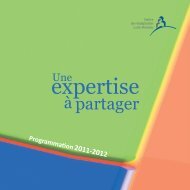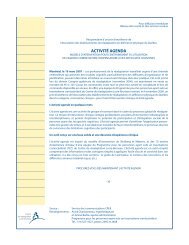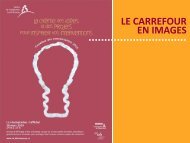recueil des communications affichées - Centre de réadaptation ...
recueil des communications affichées - Centre de réadaptation ...
recueil des communications affichées - Centre de réadaptation ...
You also want an ePaper? Increase the reach of your titles
YUMPU automatically turns print PDFs into web optimized ePapers that Google loves.
MOBILITY AMONG NEW AND EXPERIENCED OLDER ADULT POWER<br />
WHEELCHAIR USERS<br />
Paula W Rushton 1 , Louise Demers 1 , François Routhier 2 , CanWheel Research Team 3<br />
1.Université <strong>de</strong> Montréal et <strong>Centre</strong> <strong>de</strong> recherche <strong>de</strong> l‘Institut universitaire <strong>de</strong> gériatrie <strong>de</strong> Montréal; 2.Université Laval et<br />
<strong>Centre</strong> interdisciplinaire <strong>de</strong> recherche en réadaptation et intégration sociale; 3.CanWheel<br />
Mobility disability is the number one form of disability for Canadians 50 years of age and ol<strong>de</strong>r. The use of a<br />
power wheelchair is often used to compensate for mobility impairment and prevalence of use increases with<br />
age. In fact, wheelchair provision is one of the top three rehabilitation interventions that provi<strong>de</strong> the greatest<br />
increase in function and quality of life for people with severe disability.<br />
Although there is evi<strong>de</strong>nce that power wheelchairs can have a positive influence on the quality of life of ol<strong>de</strong>r<br />
adults, wheelchairs are also among the most commonly abandoned assistive technology <strong>de</strong>vices. To date, we<br />
have little comprehensive un<strong>de</strong>rstanding of power wheelchair use among ol<strong>de</strong>r adults and its impact on<br />
health and quality of life.<br />
The objective of this study was to <strong><strong>de</strong>s</strong>cribe the characteristics of experienced and new power wheelchair<br />
users at two time points, baseline and three months later. Fifty‐six ol<strong>de</strong>r adult power wheelchair users<br />
completed outcome measures assessing participation, life space travelled, wheelchair skills, wheelchair<br />
confi<strong>de</strong>nce, social support, anxiety and <strong>de</strong>pression.<br />
Results of this study indicate that while new power wheelchair users experience change in many of these<br />
areas over three months, experienced wheelchair users do not. Improved participation, subjective perception<br />
of wheelchair skills, and wheelchair confi<strong>de</strong>nce, as well as <strong>de</strong>creased anxiety were the areas in which the most<br />
change was observed.<br />
Future directions for this research inclu<strong>de</strong> following the trajectory of these two cohorts over a two year<br />
period to allow us to <strong><strong>de</strong>s</strong>cribe their mobility natural history.<br />
29


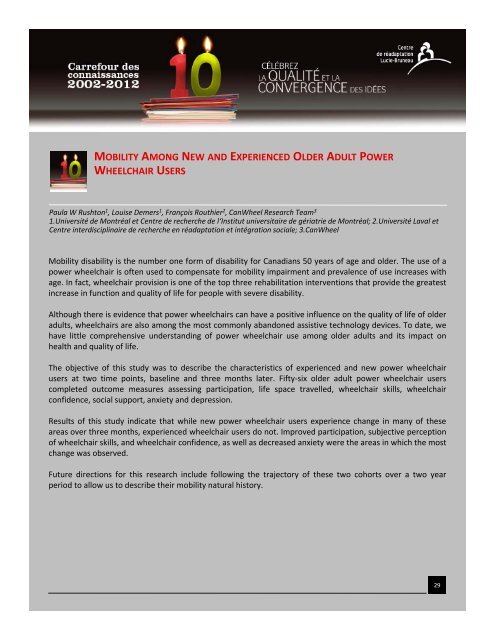
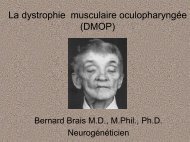
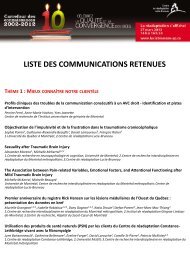
![Télécharger le questionnaire de l'IMD [PDF - 17 Ko]](https://img.yumpu.com/50142992/1/190x245/taclaccharger-le-questionnaire-de-limd-pdf-17-ko.jpg?quality=85)
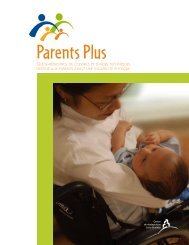
![Recueil des communications affichées - CC 2011[PDF - 1486Ko]](https://img.yumpu.com/48700479/1/190x253/recueil-des-communications-affichaces-cc-2011pdf-1486ko.jpg?quality=85)
